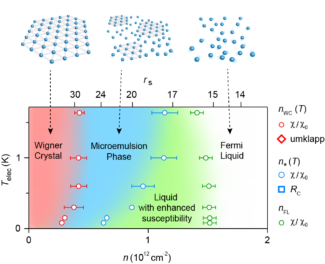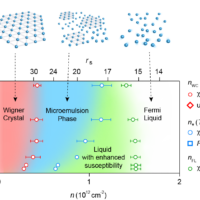News
Electrons, as quantum particles, display wave-like behavior. Forming a crystalline phase of electrons requires not only cooling but also strong Coulomb (repulsive) forces to counteract their wave-like nature. When this balance is achieved, electrons can arrange into a Wigner crystal. By adjusting electron density, a phase transition between a crystalline and liquid state can occur.
This transition from solid to liquid involves more than simple melting; theory suggests an intermediate ‘electronic microemulsion phase,’ with structures like liquid droplets within a solid. These gradual changes are driven by long-range Coulomb forces. However, characterizing these phases in solid-state systems has been challenging due to complex ordering and lattice transformations.
Recently, a team at CUA, led by Professors Hongkun Park and Eugene Demler, in close collaboration with Mikhail Lukin and Philip Kim, observed these microemulsion phases in an atomically thin semiconductor. This study provides insights into novel electron states from strong Coulomb interactions, with potential implications in the studies of ultracold polar atoms and molecules to in areas from high-temperature superconductors.

Top: Schematic of electronic phases, illustrating (from left to right) a Wigner crystal, an electronic microemulsion phase, and a Fermi liquid.
Bottom: Phase diagram of a 2D electron system as a function of electron density and temperature. Phase boundaries are obtained by the characteristic densities obtained from the spin susceptibility measurements (circles), anomalies in umklapp scattering (diamond) and anomalies in reflectance spectra (square).
